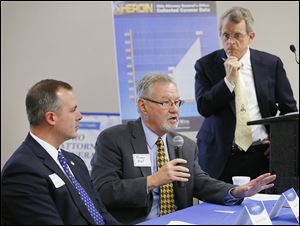
EDITORIALS
Prescribing pain
Many well-intended doctors who don’t fully understand addiction are overprescribing painkillers
12/8/2013
Hall
A heroin epidemic has afflicted much of Ohio and the rest of the country, fueled by a plentiful supply of purer, cheaper, and more addictive drugs.
An estimated 11 or more Ohioans die each week from heroin overdoses — more than 600 deaths last year, a figure that more than doubled from 2010. In Lucas County, heroin-related deaths doubled annually, from 8 in 2010 to 15 in 2011, and to 31 in 2012.
Click here to read more Blade editorials.
Much of the epidemic in opiate addiction — resulting in more deaths, crime, AIDS infections, and people in prison — starts with prescription painkillers. They affect the same pain receptors in the brain as heroin does, giving some users a sense of euphoria.
In Ohio, as in other states, satisfying an opiate addiction with heroin has become as much as 10 times cheaper than illicitly buying painkilling pills, such as Vicodin and OxyContin, on the street.
The issue finally has grabbed the attention of Ohio lawmakers, most notably state Rep. Robert Sprague (R., Findlay), chairman of a legislative study committee on prescription-drug addiction. He is introducing legislation intended to fight opioid addiction.
Affordable medication-assisted treatment and demand reduction, including drug courts, should drive any drug-fighting strategy in Ohio. But education — including physician education — must also play a central role.
Orman Hall, the director of Gov. John Kasich’s Opiate Action Team, told The Blade’s editorial page that doctors who don’t fully understand addiction likely contribute more to the problem now than do unscrupulous physicians who overprescribe for profit or fraudulent pain clinics — so-called pill mills — most of which have been closed.
The action team has issued new guidelines on opiates for emergency-room doctors. Scioto County, with 79,000 residents, reported 9.7 million doses of prescription opiates in 2010. On average, that amounts to 123 doses for every man, woman, and child in the county.
“The rates of prescribing [opiates] in many states have skyrocketed, certainly in Ohio,” Mr. Hall told The Blade. “We have well-intended doctors who don’t understand what they’re doing and [are] overprescribing.”
Making doctors more aware of the dangers of addiction, and encouraging medical schools to devote more of their curricula to the problem, would help prevent patients with legitimate needs for painkillers from becoming addicted.
From the late 1990s to 2010, the distribution rates of prescription opioids in Ohio increased ninefold. The rates of fatal overdoses from these drugs increased almost in equal measure, suggesting a strong correlation of overprescribing and overdoses.
Prescription painkillers have eased an enormous amount of pain for millions of Americans. But they have also inflicted the agony of addiction on too many.
Treatment and raising public awareness about the dangers of opioid addiction — including among the physicians who prescribe them — must become even higher priorities for Ohio in 2014.